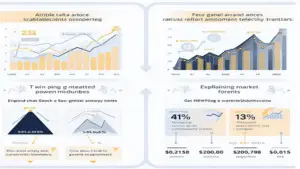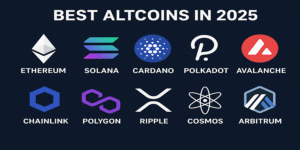How Stablecoins Maintain Peg: Mechanisms & Crypto Stability
- cryptopulse USA
- October 10, 2025
Stablecoins are cryptocurrencies designed to maintain a stable value by being linked to external assets, usually the U.S. dollar, but sometimes commodities like gold or a mix of currencies. Unlike Bitcoin or Ethereum, which can have large price fluctuations, stablecoins provide the benefits of blockchain technology—speed and efficiency—without the unpredictability that makes traditional cryptocurrencies unsuitable for everyday transactions.
The ability of stablecoins to maintain their peg directly impacts crypto stability across the entire digital asset ecosystem. When a stablecoin successfully holds its $1.00 value, you can confidently use it for trading, lending, or transferring value without worrying about sudden price drops. When that peg breaks, the consequences ripple through exchanges, DeFi protocols, and trading pairs, potentially triggering market-wide instability.
How stablecoins maintain peg mechanisms varies significantly based on their design. Some rely on traditional financial reserves held in bank accounts, while others use complex algorithms and smart contracts to adjust supply dynamically. Understanding how stablecoins work requires examining both approaches and recognizing their strengths and vulnerabilities.
This article breaks down the specific mechanisms stablecoin projects use to maintain price stability, the challenges they face during market stress, and why their success or failure matters to everyone participating in cryptocurrency markets. You’ll gain practical insights into what keeps these digital assets stable—and what can cause them to fail.
Understanding Stablecoins and Their Purpose
Stablecoins are cryptocurrencies pegged to stable assets to reduce price volatility. For example, USDT (Tether) and USDC (USD Coin) maintain a 1:1 peg with the US dollar, meaning 1 USDT ≈ $1 USD. These coins offer the speed and borderless nature of crypto while providing price certainty similar to traditional money.
How Stablecoins Work
There are different types of stablecoins, each with its own method of maintaining stability:
- Fiat-backed stablecoins: These stablecoins are backed by traditional currency held in reserve. For every token created, an equivalent amount of fiat currency is kept in a secure account. Examples include Tether (USDT) and USD Coin (USDC), where custodians hold dollars in regular banks.
- Crypto-collateralized stablecoins: Instead of using fiat currency as collateral, these stablecoins rely on other cryptocurrencies as backing. DAI is an example of this model.
- Algorithmic stablecoins: These stablecoins use smart contracts to adjust their supply based on demand. By increasing or decreasing the number of tokens in circulation, they aim to stabilize their value.
The Role of Stablecoins in the Crypto Ecosystem
Stablecoins play a crucial role in various areas of the cryptocurrency ecosystem:
- Trading pairs: Cryptocurrency exchanges use USDT and USDC as base currencies for trading pairs. This allows traders to quickly enter or exit positions without needing to convert their assets back into fiat currency.
- Cross-border remittances: Stablecoins enable fast and cost-effective international money transfers. With stablecoin transactions settling within minutes and fees often below 1%, they offer a competitive alternative to traditional remittance services.
- Decentralized finance (DeFi) protocols: Many DeFi platforms rely on stablecoins for lending, borrowing, and earning interest. By using assets with predictable values like USDC or DAI, users can have more certainty about their returns.
- Treasury management: Crypto businesses often hold operational funds in stablecoins to protect themselves from price volatility. This allows them to conduct day-to-day transactions without worrying about sudden fluctuations in the value of their assets.
Connecting Traditional Finance with Blockchain
The mechanism behind stablecoins serves as a vital link between traditional financial systems and blockchain technology. It enables the seamless transfer of value between banks and decentralized applications (dApps).
With stablecoins, you can move money from your bank account into a dApp while still having your accounting done in dollars. This combination brings together the speed and programmability benefits of cryptocurrencies with the familiarity of fiat currencies.
As institutional investors look to enter the world of digital assets, stablecoins become an important entry point for them. The stability provided by these coins is crucial for maintaining overall confidence in the crypto market.
In summary, understanding how different types of stablecoins work—including crypto-collateralized ones—and recognizing their significance within both crypto trading activities as well as broader economic contexts will help us appreciate why they matter so much today!
Also Read: Blockchain Solutions Development
Mechanisms Behind Stablecoin Peg Maintenance
The stablecoin mechanism relies on two distinct approaches to maintain price stability. Understanding how stablecoins maintain peg requires examining both asset backing and algorithmic controls—each offering unique methods to anchor value.
Asset-Backed Stablecoins
Asset-backed stablecoins operate through reserve holdings that match or exceed the circulating supply. When you hold USDT or USDC, these tokens represent claims on underlying reserves—typically U.S. dollars held in bank accounts or Treasury bills. The mechanism works through direct redemption:
- If the price drops below $1, arbitrageurs purchase the discounted stablecoin and redeem it for $1 worth of reserves, profiting from the difference while pushing the price back up.
- When the price exceeds $1, users can mint new tokens by depositing $1 of reserves, increasing supply and bringing the price down.
Algorithmic Stablecoins
Algorithmic controls take a different approach, adjusting token supply dynamically without physical reserves. These systems use smart contracts to expand or contract supply based on price movements:
- When the stablecoin trades above $1, the protocol mints new tokens, increasing supply to reduce price.
- When trading below $1, the protocol incentivizes token burning or removes tokens from circulation, decreasing supply to raise price.
This supply-demand balancing act happens automatically through coded rules, though it requires sustained market confidence to function effectively.
Stabilization Challenges and Risks in Maintaining Peg
Even with strong systems in place, stablecoins face significant challenges when market volatility increases or user confidence decreases. It’s important to know that both asset-backed and algorithmic stablecoins face different pressures during these critical times.
Challenges for Asset-Backed Stablecoins
Asset-backed stablecoins struggle with liquidity issues when large redemption requests come in all at once. This situation is similar to bank runs in traditional finance. The issuer must have enough liquid reserves to fulfill withdrawals, and any delay or inability to process redemptions can lead to panic selling. Concerns about reserve transparency and audit quality worsen these worries, especially when regulatory oversight varies across different regions.
Risks for Algorithmic Stablecoins
Algorithmic stablecoins face even greater risks of losing their peg during market downturns. Unlike asset-backed stablecoins, these tokens do not have physical collateral supporting them. Instead, they rely solely on market participants’ faith in the system’s ability to restore the peg. When prices fall below the target value, the algorithm typically creates new governance tokens or adjusts supply mechanisms. If you lose trust in the protocol’s ability to recover, you are likely to sell your position, which can trigger a downward spiral.
Contagion Effects of Lost Confidence
The loss of confidence can spread quickly. A small deviation from the peg can escalate into a full-blown crisis as traders rush to sell their positions. This pattern was witnessed during Terra’s UST collapse in 2022 when billions of dollars were wiped out within days due to a death spiral effect. The negative impact extends beyond just the stablecoin itself, affecting interconnected DeFi protocols, trading pairs, and overall investor sentiment throughout the cryptocurrency ecosystem.
Impact of Stablecoin Peg Stability on the Broader Crypto Ecosystem
When a stablecoin loses its peg, liquidity evaporates across exchanges almost instantly. You’ll notice this most clearly in trading pairs where stablecoins serve as the quote currency—USDT/BTC, USDC/ETH, and countless others. Market makers pull their orders, spreads widen dramatically, and traders scramble to exit positions. The ripple effect touches every corner of the market as arbitrage opportunities disappear and price discovery mechanisms break down.
DeFi projects face even more severe consequences. Lending protocols like Aave and Compound rely on stablecoins as collateral and borrowing assets. A de-pegging event triggers mass liquidations, creating cascading failures throughout interconnected protocols. Automated market makers on platforms like Uniswap and Curve experience severe imbalances in their liquidity pools, leading to impermanent loss for providers and slippage for traders.
The interconnected nature of crypto markets means a single stablecoin’s instability can freeze billions in total value locked across multiple chains. You’ve seen this play out during major de-pegging events where entire DeFi ecosystems temporarily ground to a halt.
Governance and Adaptability in Stablecoin Systems
Transparent governance is essential for trustworthy stablecoin operations. Governance structures determine how decisions about reserve management, protocol upgrades, and emergency responses are made. Projects like Circle (USDC) publish regular attestations from independent auditors, giving you visibility into their reserve holdings. MakerDAO takes a different approach through decentralized governance, where token holders vote on critical parameters like collateral ratios and stability fees.
The adaptability to crypto market changes separates resilient stablecoins from vulnerable ones. When market conditions shift rapidly, your stablecoin’s stabilization mechanisms must respond in real-time. Frax Finance demonstrates this principle by adjusting its collateral ratio dynamically—increasing backing during volatile periods and reducing it when markets stabilize. This flexibility allows the protocol to maintain its peg without requiring constant manual intervention.
Governance frameworks also establish accountability measures. Multi-signature wallets, time-locked contracts, and community oversight create checks and balances that prevent single points of failure. These mechanisms protect you from arbitrary changes that could compromise the peg or misuse reserves.
Future Outlook and Technological Innovations
The future of stablecoins depends heavily on enterprise digital asset technology that can handle institutional-grade requirements. Shift Markets tools represent this evolution, offering infrastructure for launching stablecoins with built-in compliance features, real-time monitoring systems, and automated reserve management. These platforms enable issuers to deploy stablecoins that respond dynamically to market conditions while maintaining regulatory standards.
Key Technological Innovations Shaping the Future of Stablecoins
Several technological innovations are expected to shape the future of stablecoins:
- Advanced Oracle Networks: These networks now provide more accurate price feeds, reducing the lag time that previously caused de-pegging events.
- Sophisticated Smart Contract Auditing Tools: These tools have become sophisticated enough to identify vulnerabilities before launch, addressing security concerns that plagued earlier algorithmic models.
- Cross-Chain Interoperability Solutions: These solutions allow stablecoins to maintain consistent pegs across multiple blockchain networks, expanding their utility without fragmenting liquidity.
- Integration of Machine Learning Algorithms: Machine learning algorithms are being integrated into stabilization mechanisms, analyzing historical patterns to predict market stress and preemptively adjust collateral ratios.
- Emergence of Hybrid Models: You’ll see hybrid models emerging that combine the reliability of asset backing with algorithmic efficiency, creating stablecoins that can scale without proportionally increasing reserve requirements.
These innovations hold great promise for overcoming the challenges faced by existing stablecoin models and enhancing their scalability, security, and interoperability.
Conclusion
Understanding how stablecoins maintain peg is crucial as these digital assets continue to reshape our financial system. You’ve learned how asset backing and algorithmic mechanisms work together to keep crypto stable, but there are still challenges ahead. The future requires ongoing innovation in collateralization methods, governance frameworks, and technological infrastructure.
As regulations become clearer and new solutions like enterprise-grade platforms develop, stablecoins are likely to become more robust. You should pay attention to how projects adjust their stabilization methods in response to market pressures while being transparent. The success of how stablecoins maintain peg directly affects whether digital currencies can truly connect traditional finance and crypto markets, making this an important area to watch as the ecosystem evolves.
FAQs (Frequently Asked Questions)
1. What are stablecoins and why are they important in the cryptocurrency ecosystem?
Stablecoins are cryptocurrencies designed to maintain a stable value, often pegged to a fiat currency like the US dollar. They play a crucial role in the crypto ecosystem by providing stability, enabling investment, trading, and remittances with low fees and fast settlement, and acting as a bridge between traditional finance and crypto markets.
2. How do stablecoins maintain their peg to ensure crypto stability?
Stablecoins maintain their peg primarily through two mechanisms: asset backing and algorithmic controls. Asset-backed stablecoins hold reserves of fiat or other assets to support their value, while algorithmic stablecoins use automated protocols to adjust supply and demand, keeping the price close to the target value, usually 1 USD.
3. What challenges and risks do stablecoins face in maintaining their peg?
Stablecoins face challenges such as market volatility, loss of confidence, and regulatory oversight. Asset-backed stablecoins risk reserve insufficiency during extreme conditions, while algorithmic stablecoins may experience de-pegging due to lack of physical collateral. These issues can lead to downward spirals, sell-offs, and overall destabilization of the crypto market.
4. How does stablecoin peg stability impact the broader cryptocurrency ecosystem?
The stability of a stablecoin’s peg directly affects liquidity across exchanges and trading pairs involving various cryptocurrencies. It also influences decentralized finance (DeFi) projects that rely on reliable stablecoin pricing for lending, borrowing, and other financial services, thereby impacting overall market health and functionality.
5. What role does governance play in maintaining stablecoin peg stability?
Transparent governance structures are vital for maintaining trust and operational integrity in stablecoin systems. Effective governance ensures adaptability in stabilization mechanisms, allowing stablecoins to respond efficiently to evolving crypto market dynamics and regulatory changes.
6. What technological innovations are shaping the future of stablecoin peg maintenance?
Emerging technologies such as enterprise digital asset platforms and tools like Shift Markets’ solutions facilitate more robust and scalable stablecoin launches. These innovations enhance stabilization mechanisms, improve transparency, and support ongoing innovation to address challenges in maintaining peg stability within the evolving crypto landscape.
Signup Newslatter
More From Crypto Guides
Best Exchanges for Trading Memecoins – Top Platforms Reviewed
Safest Crypto Wallets for US Investors: Hot vs Cold Storage
Top Crypto Wallet Apps in 2025: Secure Your Digital Assets with Ease
Beginner’s Guide to Crypto Wallets: How to Store Your Cryptocurrency Safely
More Updates

How to Leverage Blockchain technology in Fintech Solution

How Stablecoins Maintain Peg: Mechanisms & Crypto Stability

Best Exchanges for Trading Memecoins – Top Platforms Reviewed


